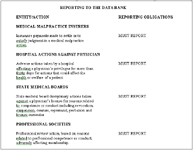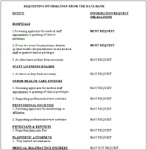Article
CALIFORNIA - NATIONAL PRACTITIONER DATA BANK
State laws and regulations that affect your medical practice
1. How did the National Practitioner Data Bank (NPDB) get started and what is its purpose?
The NPDB was established by Congress as part of the Health Care Quality Improvement Act of 1986 (42 U.S.C. 11101, et seq.) to be a central depository of information on physicians and dentists. The Data Bank collects and releases to eligible parties the following information (which is considered confidential) as it relates to the professional competence and conduct of physicians, dentists, and in some cases, other licensed health care practitioners:
2. Who and what must be reported to the Data Bank?

3. What information is not reportable?
Admission into a dependency or psychiatric rehabilitation program is not reportable.
4. Who can request information from the Data Bank and for what purpose?

5. Can a physician request information from his/her own file?
Yes. A physician may self-query the Data Banks at any time. To initiate a self-query, go to http://www.npdb-hipdb.com and click the Perform a Self-Query icon on the right side of the home page. All self-query applications must be submitted electronically through the website. Payment must be by credit card. In addition, a signed and notarized copy must be mailed to the Data Banks to complete the self-query process:
NPDB-HIPDB
4094 Majestic Lane, PMB-332
Fairfax, Virginia 22033
Physicians who do not have access to the Internet may call the NPDB-HIPDB Customer Service Center for assistance at 1-800-767-6732.
When the Data Banks process a report, a Report Verification Document is sent to the reporting entity, and a Notification of a Report in the Data Bank(s) is sent to the physician, who should review the report for accuracy.
NPDB does not accept stamped, photocopied or faxed signatures.
5. What happens when a report is made against a physician?
Physicians should review the report for accuracy, including such information as current address and place of employment. If any information in a report is inaccurate, the subject must contact the reporting entity to request that it file a correction to the report. If the reporting entity does not correct the information, the physician may add a statement or initiate a dispute (disputes discussed below).
The physician may add a statement to a report at any time. When the statement is processed, it will be sent to all queriers who previously received the report, and will be included when released to future queriers. Statements are limited to 2,000 characters.
6. What remedy does a physician have when the Data Bank information is inaccurate or if the physician wishes to initiate a dispute?
The physician must access the Report Response Service from the NPDB-HIPDB home page, and click Respond to a Report. The physician must use the unique report number and password provided in his or her Notification to access the Report Response Service. On the Report Response Options screen, the physician can correct or update his home and/or work address and also add, modify or withdraw a dispute or Subject Statement.
When a physician initiates a dispute on-line, notification of the dispute will be sent to all queriers who received the report in the last 3 years and is included in the report when released to future queriers. There are three possible outcomes for a dispute:
A. The reporting entity corrects the report;
B. The reporting entity voids the report; or
C. The reporting entity declines to change the report.
If the reporting entity declines to change the disputed report or takes no action, the physician may request that the Secretary of Health and Human Services (HHS) review the report. A request for Secretary review must be initiated through the on-line Report Response Service. Any accompanying documentation must be sent to the Data Banks, not directly to the Secretary. The physician must state clearly the facts in dispute, submit documentation that substantiates that the reporting entity's information is inaccurate (may not exceed 10 pages), and proof that the physician attempted to resolve the disagreement with the reporting entity.
The physician must wait 30 days from the date of initiating the dispute with the reporting agency before requesting Secretary review. The Secretary will review disputed reports only for accuracy of factual information and to ensure that the information was required to be reported. The Secretary will not review the merits of a malpractice claim or the basis for an adverse action. There are three possible outcomes for HHS review of a dispute:
A. The Secretary concludes that the report is accurate;
B. The Secretary concludes that the report is inaccurate; or
C. The Secretary concludes that the issues in dispute are outside the scope of Secretarial Review.
Copyright Kern Augustine Conroy and Schoppmann, P.C. Used with permission.





